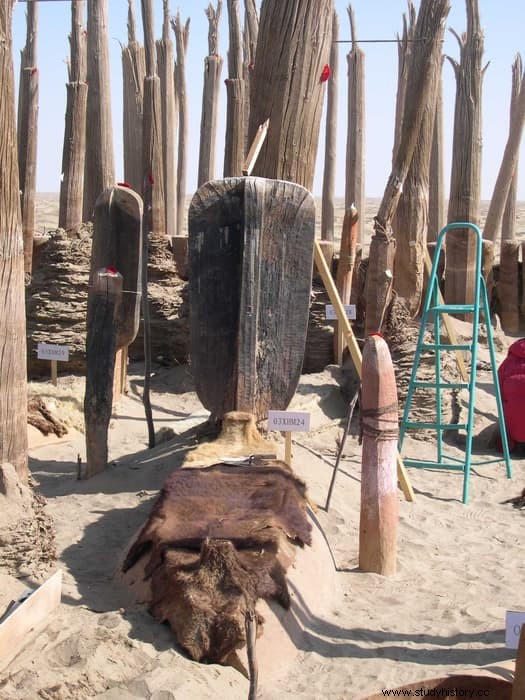As part of the Silk Road and situated at the geographic intersection of Eastern and Western cultures, the Xinjiang Uyghur Autonomous Region has long been an important crossroads for trans-European exchanges of people, cultures, agriculture, and languages.
Since the late 1990s, the discovery of hundreds of naturally mummified human remains dating from between 2000 B.C. and 200 AD. in the region's Tarim Basin has attracted international attention due to its so-called Western physical appearance , its woven and felted wool clothes, and its agro-pastoral economy that included cattle, sheep, and goats, wheat, barley, millet, and even kefir cheese.

Buried in ship coffins in a barren desert, the Tarim Basin mummies have long baffled scientists and inspired numerous theories about their enigmatic origin.
The cattle-centric economy of the Tarim Basin mummies and their unusual physical appearance have led some scholars to speculate that they were descendants of the Yamna migratory herders, a highly mobile Bronze Age society from the steppes of the Black Sea region in southern Russia. Others have placed their origins among the Central Asian desert oasis cultures of the Bactria-Margiana Archaeological Complex (BMAC), a group with strong genetic links to early farmers on the Iranian plateau.

To better understand the origin of the population of the Tarim Basin mummies, which first settled in the region in places like Xiaohe and Gumugou around 2000 B.C., a team of international researchers from Jilin University, the The Institute of Vertebrate Paleontology and Paleoanthropology, the Max Planck Institute for Evolutionary Anthropology, Seoul National University (Korea), and Harvard University generated and analyzed genome data from thirteen of the earliest known Tarim Basin mummies, dated between 2100 and 1700 BC, along with five individuals dated between 3000 and 2800 BC. in the neighboring Dzungaria basin. This is the first genome-wide study of prehistoric populations in the Xinjiang Uyghur Autonomous Region, and includes the earliest human remains discovered in the region to date.
To their great surprise, the researchers discovered that the Tarim Basin mummies were by no means newcomers to the region, but rather appeared to be direct descendants of a Pleistocene population that was once widespread and had largely disappeared by the end. of the last Ice Age. This population, known as the ancient North Eurasians (ANE), only survives in a fractional way in the genomes of current populations, with the indigenous populations of Siberia and America presenting the highest known proportions, with approximately 40%.

In contrast to present-day populations, the Tarim Basin mummies show no evidence of admixture with any other Holocene groups, instead forming a hitherto unknown genetic isolate that likely suffered from an extreme and prolonged genetic bottleneck before settling. in the Tarim Basin.
Archaeogeneticists have long sought Holocene populations of the ANE (Ancient North Eurasians) to better understand the genetic history of inner Eurasia. We found one in the most unexpected place , says Choongwon Jeong, lead author of the study and professor of Biological Sciences at Seoul National University.
Unlike the Tarim Basin, the earliest inhabitants of the neighboring Dzungarian Basin were descended not only from local populations, but also from western steppe herders, specifically the Afanasievo, a pastoral group with strong genetic links to the Yamna of the Tarim Basin. Early Bronze Age. Genetic characterization of the Early Bronze Age Dzungars also helped clarify the ancestry of other pastoral groups known as the Chemurcheks, who later spread north into the Altai Mountains and into Mongolia. The Chemurchek groups appear to be the descendants of the Early Bronze Age Dzungarian and Inner Asian Mountain Corridor (IAMC) Central Asian groups, deriving their ancestry from both local populations and agro-pastoralists of the BMAC. Bactrian-Margiana).
These findings contribute to our understanding of the eastward dispersal of Yamna ancestors and the settings in which admixture occurred when they first encountered Inner Asian populations , says Chao Ning, a co-author of the study and a professor at Peking University's School of Archeology and Museology.

These findings of extensive genetic admixture throughout the Tarim Basin during the Bronze Age make it all the more surprising that the Tarim Basin mummies did not show any evidence of genetic admixture. However, although the Tarim Basin groups were genetically isolated, they were not culturally isolated. Proteomic analysis of his dental calculus confirmed that the founding population already practiced cattle, sheep, and goat farming, and that they were well versed in the different cultures, cuisines, and technologies around them.
Despite being genetically isolated, the Bronze Age peoples of the Tarim Basin were culturally extraordinarily cosmopolitan, building their cuisine around West Asian wheat and dairy products, millet from East Asia and medicinal plants such as ephedra from Central Asia , says Christina Warinner, lead author of the study, Professor of Anthropology at Harvard University and head of a research group at the Max Planck Institute for Evolutionary Anthropology in Leipzig, Germany.
Reconstructing the origins of the Tarim Basin mummies has had a transformative effect on our understanding of the region, and we will continue to study ancient human genomes in other eras to gain a deeper understanding of the history of human migration in the Eurasian steppes , adds Yinquiu Cui, lead author of the study and a professor at Jilin University's College of Life Sciences.
